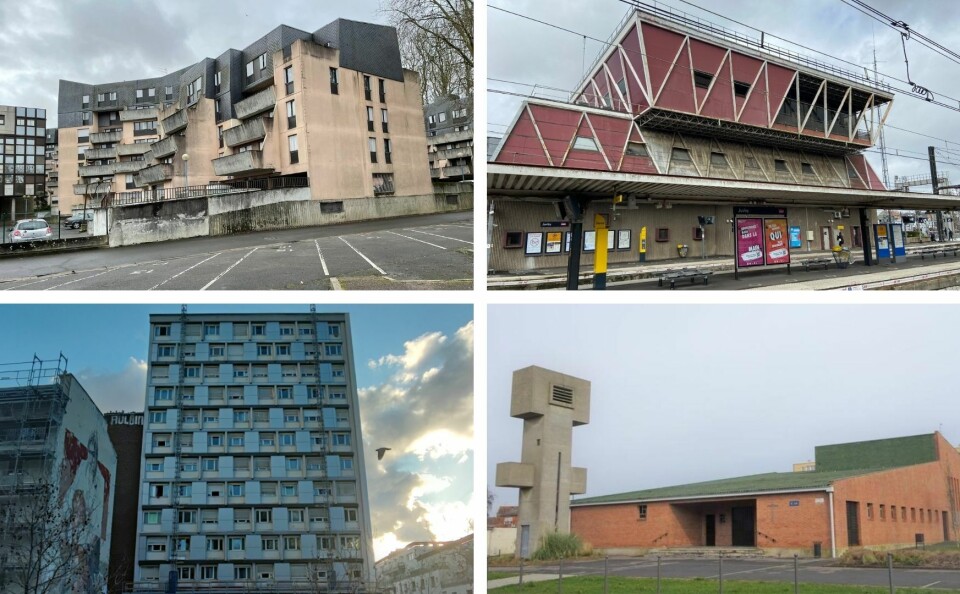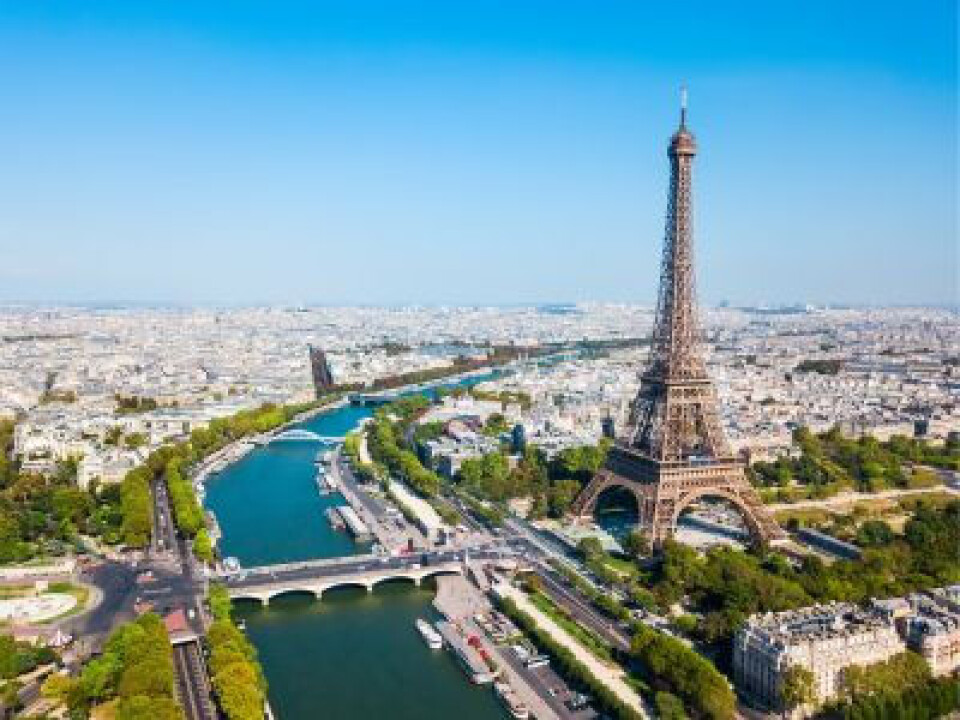-
Know your cheeses and their seasons: which to eat in France in February
Cow’s milk cheeses dominate as winter comes to an end
-
Films and series to watch in February to improve your French
Every month we outline good film and TV series to improve your language
-
PHOTOS: French villagers had no idea their neighbour was an acclaimed American artist
Frances Butler exhibited in some of the world’s leading museums, including the Victoria & Albert and British Museum in London
Twitter account devoted to France’s ‘ugliest’ architecture under fire
Critics posting photos of ‘local horrors’ do not appreciate buildings’ social or historic context, say architects

A Twitter account with nearly 80,000 followers is questioning the aesthetics of modern architecture in France by highlighting some of the ugliest examples from around the country.
La France Moche (ugly France) posts photos of bizarre, dilapidated or ill-conceived buildings.
“We’ve got a lot of them,” the account description reads, encouraging followers to send in their own “local horrors” for all to enjoy.
However, it has come under fire for promoting a skewed image of modern buildings and being too quick to write off architectural styles without fully understanding them.
Read more: Contest for ugliest places in France reveals top contenders
‘Urbanism tells us who we are’
The account borrows its name from a landmark article published in 2010 in Télérama, the weekly French cultural and television magazine.
The feature took a deep dive into the historic, political and economic factors that have turned parts of France into what it called “suburban metastasis”.
It charted the slow erosion of France’s natural landscape to develop cookie-cutter towns, sprawling commercial and business centres in suburban areas, motorways, concrete buildings and giant billboards.
“Urbanism tells us who we are,” it said. “The Middle Ages had their fortified towns and cathedrals, the 19th century its boulevards. We have our commercial hangars and housing schemes.”
It also denounced the tunnels of advertising in commercial centres, insisting “our windscreens act like TV screens”.
Advertising hoardings are ‘public space harassment’
Today there is even a Prix de la France Moche, set up by an association fighting the spread of these advertising hoardings.
Paysages de France tried to award prizes to towns that made significant efforts to get rid of illegal advertising “but found it difficult to find any”, the association’s Jean-Marie Delalande told The Connexion in 2021.
From the late 1980s to the early 2000s, some towns had kilometres of advertising panels along main roads into the built-up areas, even though a law setting out strict controls had been on the books since 1979.
The association was founded in 1993, and initially concerned itself with a range of issues pertaining to the protection of the French visual environment before shifting its focus to advertising panels.
Paysages de France was active in the Grenelle de l’Environnement debate in 2007, and succeeded in getting the laws tightened further.
Although there has been some improvement since then, it says the rules are still flouted and enforcement is left to mayors and prefects.
“Advertising has become very aggressive and intrusive in our daily lives,” says
Olivier Saladin, Paysages de France’s spokesman. “It’s public space harassment.”
High-rise housing dominated 1950’s urban architecture
Villard-de-Lans (Isère), Avenue des Loisirs in Moussac (Gard), the commercial centre of Aubières (Puy-de-Dôme) and the Chaussée Royale in Saint-Paul (Réunion) are the latest recipients of the France Moche award in 2022.
Of course, the issue of aesthetic appeal (or lack of it) in architecture is not new.
In the early 20th century, for example, French writer Jean Giraudoux branded the urban planning situation in Paris suburbs “a horrendous misery zone”.
He was similarly scathing about housing schemes that took off in the late 1930s, coinciding with the explosion of cars.
In the 1950s, urban architecture was dominated by the grand ensemble – the large-scale high-rise housing estate.
Architect Charles-Édouard Jeanneret-Gris – known as Le Corbusier – embodies that period in France, notably with La Cité Radieuse in Marseille.
This concrete unité d’habitation (housing block) was built to accommodate 1,600 residents, with a school, a swimming pool, shops and even an arts centre, and is on Unesco’s World Heritage list.
Not all examples from that period are so celebrated.
Read more: Villa E-1027: A modernist masterpiece Riviera property restored
1970s TV show about controversial building projects
A lot of the buildings and tower blocks erected during the grand ensemble era suffered from state budget cuts, leaving the door open to standardisation and questionable aesthetics.
That, at least, is the theory set out by Mr de Jarcy in his 2019 book Les abandonnées, which insists the errors of urban planning and social segregation that we see today have their root in this period.
La France défigurée, a popular 1970s TV show, also took an interest in interrogating the ‘visual pollution’ caused by advertising and buildings, with its presenters regularly visiting construction sites or developments that were the subject of controversy.
The real issue with France Moche Twitter account
The issue upsetting architects with the France Moche Twitter account, however, is the lack of context and curation.
Caroline Mazel, lecturer at Ensap Bordeaux architecture school, says: “Critical thinking requires a bit of culture and education.”
She says the posts are a hodgepodge of content that groups disparate structures – from roundabouts to commercial centres, some new, others in various states of dereliction – under the same umbrella.
“Everything is debated, but nothing is comparable,” she says, adding that placing everything in the same architectural and historical context creates confusion.
Mr de Jarcy agrees that qualifying the posts would be helpful, admitting he does not think all the photos featured on the account deserve to be there.
Many people hated the Eiffel Tower
Dr Mazel points out that some of the buildings that have been featured are by architects whose works have been designated as monuments historiques.
“The Eiffel Tower was described by one critic after its construction as ‘a hole-riddled suppository’ and it is now France’s national symbol,” she says, explaining why some buildings need to be appreciated for their social, political or historic significance.

Photo: The Eiffel Tower dominates the Paris skyline and was not popular with everyone once completed in 1889; Credit: saiko3p / Shutterstock
Grand ensemble policy, she continues, was meant to provide affordable housing in high-density areas to working-class families, and that should be taken into account when measuring its worth.
As an expert on 20th century buildings and author of a book on French people’s attitude to architecture, Dr Mazel is keen for better education to help people understand, appreciate and inhabit buildings.
For Mr de Jarcy, however, that argument is “an admission of weakness”.
He insists architecture should be conceptualised for future residents rather than for satisfying an architect’s ego.
Read more: The Paris suburb housing estate that is like no other in France
‘Architects continue to get it wrong’
As Francis Rambel, from the Cité de l’architecture et du patrimoine de Paris, told the 20 Minutes podcast: “Architecture is everything except performance. It talks about space, use, and urbanity. Is the habitat liveable? Is the use pleasant? Does it create a link and vivre-ensemble?”
For now, ugly architecture is something we will have to carry on living with, says Mr de Jarcy.
He cites the ongoing redevelopment of Porte de la Chapelle in Paris as a prime example of architects continuing to get it wrong, comparing the buildings there to shoeboxes in their “grey-toned, rectangular uniformity”.
“When you see them, you can’t help but wonder whether the architects want residents to commit suicide by jumping from the windows.”
Related articles
Plain sailing? Not for the Paris art museum inspired by a ship
French planning row over ugly McDonald’s ‘site cabin’ extension
Find Paris’s secret village hidden in the bustling Marais district
























